事务
- 1、 事务概述
- 2、spring对事务的支持
- 2.1 spring事务管理API
- 2.2 事务属性
- 2.2.1 事务传播行为
- 2.2.2 案例
- 2.2.2.1 REQUIRED
- 2.2.2.2 REQUIRES_NEW
- 2.2.2.3 NESTED
- 2.2.3 事务隔离行为
- 2.2.3.1 测试
- 2.2.3.2 读未提交
- 2.2.3.3 读提交
- 2.2.3.4 可重复读
- 2.2.4 事务超时
- 2.2.5 只读事务
- 2.2.6 设置哪些异常回滚事务
- 2.2.7 设置哪些异常不回滚事务
- 2.3 事务全注解开发
1、 事务概述
● 什么是事务
○ 在一个业务流程当中,通常需要多条DML(insert delete update)语句共同联合才能完成,这多条DML语句必须同时成功,或者同时失败,这样才能保证数据的安全。
○ 多条DML要么同时成功,要么同时失败,这叫做事务。
○ 事务:Transaction(tx)
● 事务的四个处理过程:
○ 第一步:开启事务 (start transaction)
○ 第二步:执行核心业务代码
○ 第三步:提交事务(如果核心业务处理过程中没有出现异常)(commit transaction)
○ 第四步:回滚事务(如果核心业务处理过程中出现异常)(rollback transaction)
● 事务的四个特性:
○ A 原子性:事务是最小的工作单元,不可再分。
○ C 一致性:事务要求要么同时成功,要么同时失败。事务前和事务后的总量不变。
○ I 隔离性:事务和事务之间因为有隔离性,才可以保证互不干扰。
○ D 持久性:持久性是事务结束的标志。
2、spring对事务的支持
两种方式:
● 编程式事务
○ 通过编写代码的方式来实现事务的管理。(比如自己写切面类
● 声明式事务
○ 基于注解方式
○ 基于XML配置方式
2.1 spring事务管理API
spring实现了事务的接口,可以帮助我们管理事务。其实底层也是基于AOP切面编程实现的。
Spring对事务的管理底层实现方式是基于AOP实现的。采用AOP的方式进行了封装。所以Spring专门针对事务开发了一套API,API的核心接口如下:
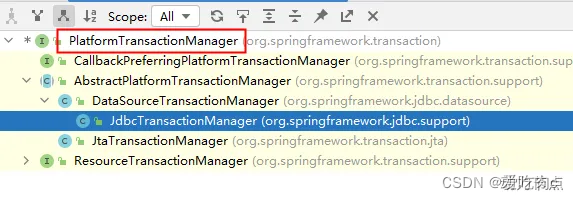
PlatformTransactionManager接口:spring事务管理器的核心接口。在Spring6中它有两个实现:
● DataSourceTransactionManager:支持JdbcTemplate、MyBatis、Hibernate等事务管理。
● JtaTransactionManager:支持分布式事务管理。
如果要在Spring6中使用JdbcTemplate,就要使用DataSourceTransactionManager来管理事务。(Spring内置写好了,可以直接用。)
我们只需要在配置文件中配置 然后使用注解方式即可。
配置文件中导入tx命名空间
<?xml version="1.0" encoding="UTF-8"?>
<beans xmlns="http://www.springframework.org/schema/beans"xmlns:xsi="http://www.w3.org/2001/XMLSchema-instance"xmlns:context="http://www.springframework.org/schema/context"xmlns:tx="http://www.springframework.org/schema/tx"xsi:schemaLocation="http://www.springframework.org/schema/beans http://www.springframework.org/schema/beans/spring-beans.xsdhttp://www.springframework.org/schema/context http://www.springframework.org/schema/context/spring-context.xsdhttp://www.springframework.org/schema/tx http://www.springframework.org/schema/tx/spring-tx.xsd"></beans>
配置事务管理器
dataSource 是一个数据源 可以配置自己的数据源
<bean id="transactionManager" class="org.springframework.jdbc.datasource.DataSourceTransactionManager"><property name="dataSource" ref="dataSource"/>
</bean>
spring配置文件中配置“事务注解驱动器”,开始注解的方式控制事务。
<tx:annotation-driven transaction-manager="transactionManager"/>
在类上添加注解
● 在service类上或方法上添加@Transactional注解
在类上添加该注解,该类中所有的方法都有事务。在某个方法上添加该注解,表示只有这个方法使用事务。
2.2 事务属性
事务属性包括哪些
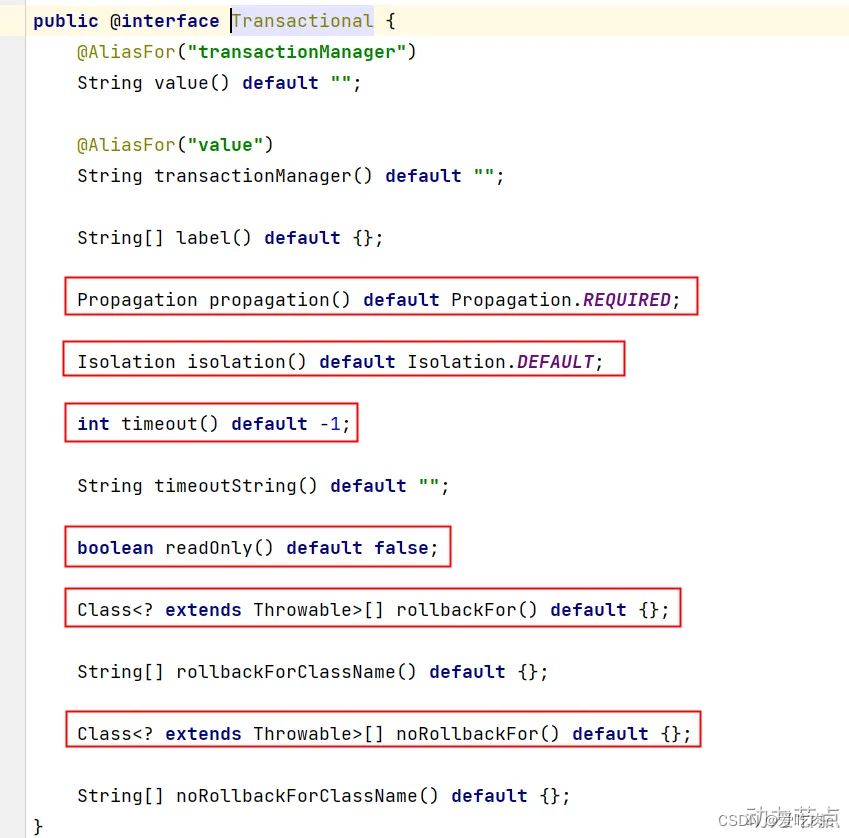
事务中的重点属性:
● 事务传播行为
● 事务隔离级别
● 事务超时
● 只读事务
● 设置出现哪些异常回滚事务
● 设置出现哪些异常不回滚事务
2.2.1 事务传播行为
什么是事务的传播行为?
在service类中有a()方法和b()方法,a()方法上有事务,b()方法上也有事务,当a()方法执行过程中调用了b()方法,事务是如何传递的?合并到一个事务里?还是开启一个新的事务?这就是事务传播行为。
事务传播行为在spring框架中被定义为枚举类型:
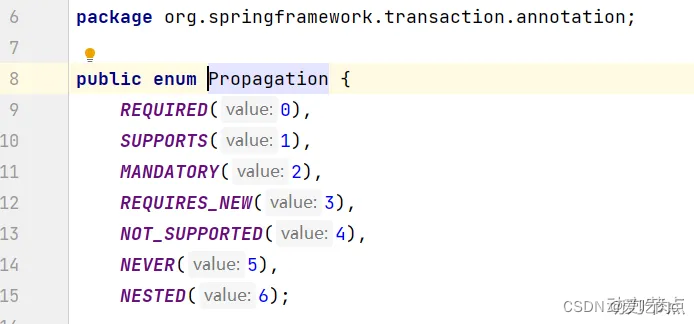
一共有七种传播行为:
● REQUIRED:支持当前事务,如果不存在就新建一个(默认)【没有就新建,有就加入】
(内部事务失败回滚了 外部事务无法执行,即使捕捉到了异常,外部事物也无法继续。)
● SUPPORTS:支持当前事务,如果当前没有事务,就以非事务方式执行【有就加入,没有就不管了】
● MANDATORY:必须运行在一个事务中,如果当前没有事务正在发生,将抛出一个异常【有就加入,没有就抛异常】
● REQUIRES_NEW:开启一个新的事务,如果一个事务已经存在,则将这个存在的事务挂起【不管有没有,直接开启一个新事务,开启的新事务和之前的事务不存在嵌套关系,之前事务被挂起】(内部发生异常,外部事物依然可以执行。是两个相互独立的事务,互不影响。外部事务回滚不会影响到内部事务。)
● NOT_SUPPORTED:以非事务方式运行,如果有事务存在,挂起当前事务【不支持事务,存在就挂起】
● NEVER:以非事务方式运行,如果有事务存在,抛出异常【不支持事务,存在就抛异常】
● NESTED:如果当前正有一个事务在进行中,则该方法应当运行在一个嵌套式事务中。被嵌套的事务可以独立于外层事务进行提交或回滚。如果外层事务不存在,行为就像REQUIRED一样。【有事务的话,就在这个事务里再嵌套一个完全独立的事务,嵌套的事务可以独立的提交和回滚。没有事务就和REQUIRED一样。】(内部事务是外部事务的一个子事务,如果外部事务回滚,则内部事务也回滚,内部事务回滚不会影响到外部事务.)
2.2.2 案例
@Resource(name = "accService2")private AccountService accountService;@Transactional(propagation = Propagation.REQUIRED)public int insert1(){Account account=new Account("act008",10000.0);int i = accountDao.insert(account);i+=accountService.insert1();return i;}
@Transactional(propagation = Propagation.REQUIRED)@Overridepublic int insert1() {Account account=new Account("act007",10000.0);int i = accountDao.insert(account);return 0;}2.2.2.1 REQUIRED
REQUIRED

通过日志输出,我们可以看出REQUIRED,没有事务,自动创建一个新的,有时,就加入。模拟异常如果事务有异常,则都回滚,无法提交。即使外部处理了异常,也无法继续执行。
@Transactional(propagation = Propagation.REQUIRED)@Overridepublic int insert1() {Account account=new Account("act009",10000.0);String a=null;a.toString();int i = accountDao.insert(account);return i;}
2.2.2.2 REQUIRES_NEW
`REQUIRES_NEW
@Resource(name = "accService2")private AccountService accountService;@Transactional(propagation = Propagation.REQUIRED)public int insert1(){Account account=new Account("act0010",10000.0);int i = accountDao.insert(account);i+=accountService.insert1();System.out.println("aaa");return i;}
@Transactional(propagation = Propagation.REQUIRES_NEW)@Overridepublic int insert1() {Account account=new Account("act009",10000.0);String a=null;a.toString();int i = accountDao.insert(account);return i;}
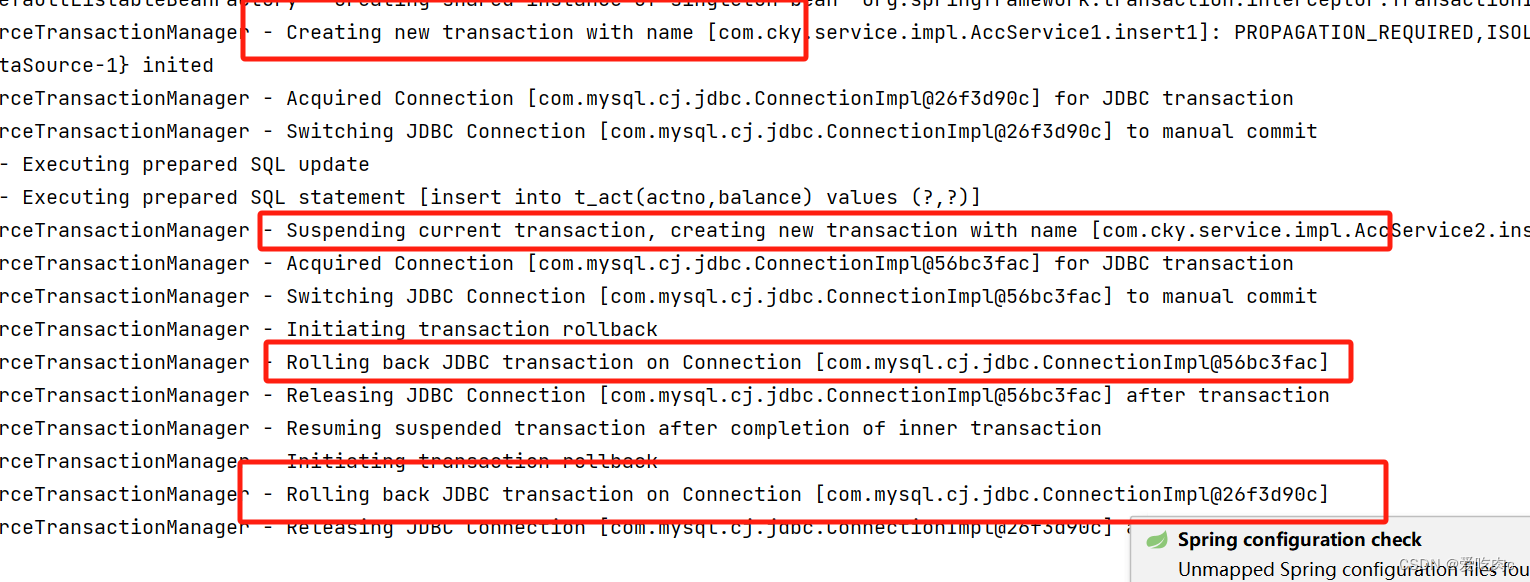
是两个相互独立的事务,内部执行,外部挂起,内部回滚,接着回到外部事务处,但是由于外部事务没有处理异常,所以也回滚了。
@Transactional(propagation = Propagation.REQUIRED)public int insert1(){Account account=new Account("act0010",10000.0);int i = accountDao.insert(account);try {i += accountService.insert1();System.out.println("aaa");}catch (Exception e){System.out.println("错误");}return i;}
如果外部处理了异常 则外部可以正常执行,只有内部事务回滚
插入成功.
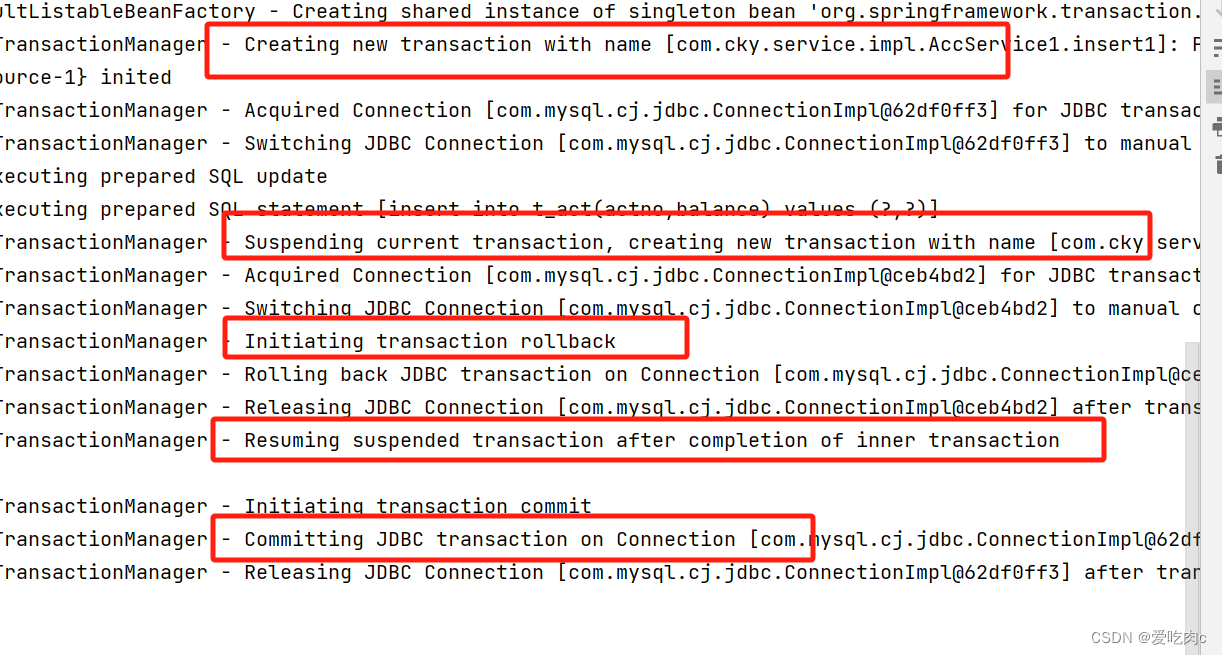

如果内部事务正常,则内部事务可以独立提交,外部事务回滚不影响内部事务
2.2.2.3 NESTED
NESTED
@Transactional(propagation = Propagation.REQUIRED)public int insert1(){Account account=new Account("act0010",10000.0);int i = accountDao.insert(account);i += accountService.insert1();System.out.println("aaa");String a=null;a.toString();return i;}
@Transactional(propagation = Propagation.NESTED)@Overridepublic int insert1() {Account account=new Account("act009",10000.0);int i = accountDao.insert(account);return i;}
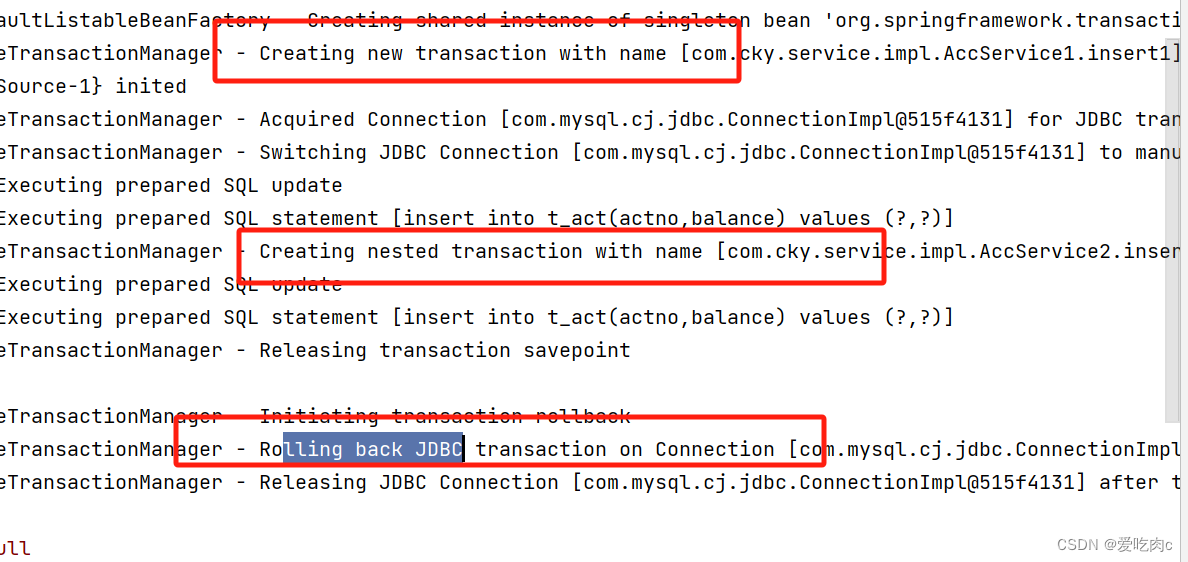
NESTED 内部事务是外部事物的一个子事务,外部回滚则内部也回滚。
如果内部异常,且外部没有处理异常,则外部也无法正常执行,如果内部异常,但是外部事务处理了异常,则外部事务可以正常提交。
自己总结:REQUIRED是一个事务,即使外部处理了异常,也都要回滚。REQUIRED_NEW,是两个独立的事务,外部异常,不影响内部正常提交。NESTED子事务,外部回滚,内部就要回滚,但是内部回滚,只要外部处理了,外部就可以正常执行。
2.2.3 事务隔离行为
事务隔离级别类似于教室A和教室B之间的那道墙,隔离级别越高表示墙体越厚。隔音效果越好。
数据库中读取数据存在的三大问题:(三大读问题)
● 脏读:读取到没有提交到数据库的数据,叫做脏读。
● 不可重复读:在同一个事务当中,第一次和第二次读取的数据不一样。
● 幻读:读到的数据是假的。
事务隔离级别包括四个级别:
● 读未提交:READ_UNCOMMITTED
○ 这种隔离级别,存在脏读问题,所谓的脏读(dirty read)表示能够读取到其它事务未提交的数据。
● 读提交:READ_COMMITTED
○ 解决了脏读问题,其它事务提交之后才能读到,但存在不可重复读问题。
● 可重复读:REPEATABLE_READ
○ 解决了不可重复读,可以达到可重复读效果,只要当前事务不结束,读取到的数据一直都是一样的。但存在幻读问题。
● 序列化:SERIALIZABLE
○ 解决了幻读问题,事务排队执行。不支持并发。
大家可以通过一个表格来记忆:

在Spring代码中如何设置隔离级别?
隔离级别在spring中以枚举类型存在:
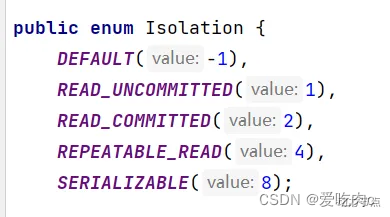
比如在类上或方法上加
@Transactional(isolation = Isolation.READ_COMMITTED)
2.2.3.1 测试
测试事务隔离级别:
怎么测试:一个service负责插入,一个service负责查询。负责插入的service要模拟延迟。
负责查询的类
package com.cky.service.impl;import com.cky.Dao.AccountDao;
import com.cky.pojo.Account;
import jakarta.annotation.Resource;
import org.springframework.stereotype.Service;
import org.springframework.transaction.annotation.Isolation;
import org.springframework.transaction.annotation.Transactional;@Service("i1")
public class isolataionService1 {@Resource(name = "accountDao")private AccountDao accountDao;@Transactional(isolation = Isolation.READ_UNCOMMITTED)public void query(){Account account = accountDao.selectByActno("act0030");System.out.println(account);}}负责插入的类 并且有延迟
package com.cky.service.impl;import com.cky.Dao.AccountDao;
import com.cky.pojo.Account;
import jakarta.annotation.Resource;
import org.springframework.stereotype.Service;
import org.springframework.transaction.annotation.Isolation;
import org.springframework.transaction.annotation.Transactional;@Service("i2")
public class isolataionService2 {@Resource(name = "accountDao")private AccountDao accountDao;@Transactional(isolation = Isolation.READ_UNCOMMITTED)public void insert(){accountDao.insert(new Account("act0030",2000.0));try {Thread.sleep(1000*20);} catch (InterruptedException e) {e.printStackTrace();}}
}2.2.3.2 读未提交
我们首先设置读未提交
就是可以读到还没有提交到数据库中缓存中的信息
@Testpublic void testisolation(){ApplicationContext applicationContext = new ClassPathXmlApplicationContext("spring.xml");isolataionService1 i1 = applicationContext.getBean("i1", isolataionService1.class);i1.query();}@Testpublic void testisolation1(){ApplicationContext applicationContext = new ClassPathXmlApplicationContext("spring.xml");isolataionService2 i2 = applicationContext.getBean("i2", isolataionService2.class);i2.insert();}
先执行testisolation1 在执行testisolation。
我们可以看到 数据表中还没有内容,但是我们可以读取到

2.2.3.3 读提交
设置读提交
还是上边的程序,我们可以看到并查询不到内容,因为还没有保存在数据库里

2.2.3.4 可重复读
设置可重复读
这里用来查询 前后延迟五秒查询 且在这五秒内 更新数据库内容,看查询内容是否一致。
package com.cky.service.impl;import com.cky.Dao.AccountDao;
import com.cky.pojo.Account;
import jakarta.annotation.Resource;
import org.springframework.stereotype.Service;
import org.springframework.transaction.annotation.Isolation;
import org.springframework.transaction.annotation.Transactional;@Service("i1")
public class isolataionService1 {@Resource(name = "accountDao")private AccountDao accountDao;@Transactional(isolation = Isolation.REPEATABLE_READ)public void query(){Account account = accountDao.selectByActno("act0040");System.out.println(account);try {Thread.sleep(1000*5);} catch (InterruptedException e) {}Account account1 = accountDao.selectByActno("act0040");System.out.println(account1);}}用来更新
package com.cky.service.impl;import com.cky.Dao.AccountDao;
import com.cky.pojo.Account;
import jakarta.annotation.Resource;
import org.springframework.stereotype.Service;
import org.springframework.transaction.annotation.Isolation;
import org.springframework.transaction.annotation.Transactional;@Service("i2")
public class isolataionService2 {@Resource(name = "accountDao")private AccountDao accountDao;@Transactional(isolation = Isolation.READ_UNCOMMITTED)public void insert(){accountDao.insert(new Account("act0040",2000.0));}public void update(){accountDao.update(new Account("act0040",6000.0));}
}测试 在类上点击test 一起测试
package com.cky.test;import com.cky.service.AccountService;
import com.cky.service.UserService;
import com.cky.service.impl.isolataionService1;
import com.cky.service.impl.isolataionService2;
import org.junit.Test;
import org.slf4j.Logger;
import org.slf4j.LoggerFactory;
import org.springframework.context.ApplicationContext;
import org.springframework.context.support.ClassPathXmlApplicationContext;public class test {@Testpublic void testisolation(){ApplicationContext applicationContext = new ClassPathXmlApplicationContext("spring.xml");isolataionService1 i1 = applicationContext.getBean("i1", isolataionService1.class);i1.query();}@Testpublic void testisolation1(){ApplicationContext applicationContext = new ClassPathXmlApplicationContext("spring.xml");isolataionService2 i2 = applicationContext.getBean("i2", isolataionService2.class);i2.update();}
}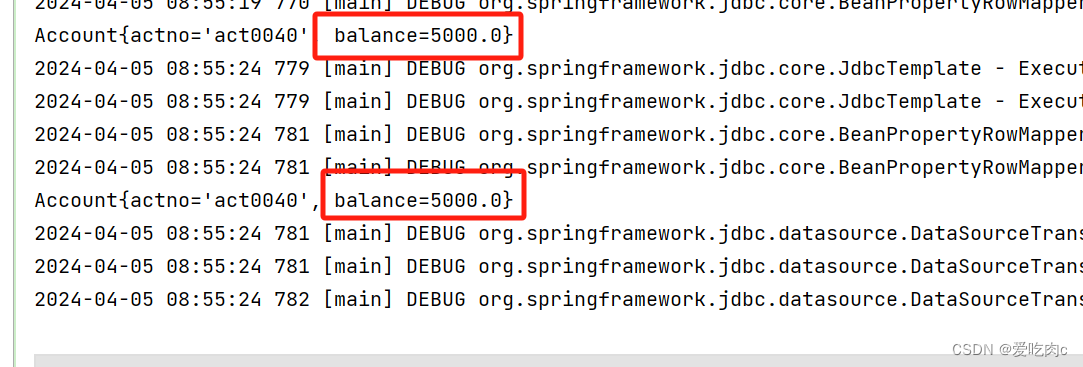
可以看到读取的内容一致。更新并没有造成影响。
2.2.4 事务超时
@Transactional(timeout = 10)
以上代码表示设置事务的超时时间为10秒。
表示超过10秒如果该事务中所有的DML语句还没有执行完毕的话,最终结果会选择回滚。
默认值-1,表示没有时间限制。
这里有个坑,事务的超时时间指的是哪段时间?
在当前事务当中,最后一条DML语句执行之前的时间。如果最后一条DML语句后面很有很多业务逻辑,这些业务代码执行的时间不被计入超时时间。
以下代码的超时不会被计入超时时间
@Transactional(timeout = 10) // 设置事务超时时间为10秒。
public void save(Account act) {accountDao.insert(act);// 睡眠一会try {Thread.sleep(1000 * 15);} catch (InterruptedException e) {e.printStackTrace();}
}
以下代码的超时会被计入超时时间
@Transactional(timeout = 10) // 设置事务超时时间为10秒。
public void save(Account act) {// 睡眠一会try {Thread.sleep(1000 * 15);} catch (InterruptedException e) {e.printStackTrace();}accountDao.insert(act);
}
2.2.5 只读事务
@Transactional(readOnly = true)
将当前事务设置为只读事务,在该事务执行过程中只允许select语句执行,delete insert update均不可执行。
该特性的作用是:启动spring的优化策略。提高select语句执行效率。
如果该事务中确实没有增删改操作,建议设置为只读事务。
2.2.6 设置哪些异常回滚事务
@Transactional(rollbackFor = RuntimeException.class)
只有发生RuntimeException异常或该异常的子类异常才回滚。
2.2.7 设置哪些异常不回滚事务
@Transactional(noRollbackFor = NullPointerException.class)
表示发生NullPointerException或该异常的子类异常不回滚,其他异常则回滚。
2.3 事务全注解开发
一个配置类来代替sprin.xml文件
package com.powernode.bank;import com.alibaba.druid.pool.DruidDataSource;
import org.springframework.context.annotation.Bean;
import org.springframework.context.annotation.ComponentScan;
import org.springframework.context.annotation.Configuration;
import org.springframework.jdbc.core.JdbcTemplate;
import org.springframework.jdbc.datasource.DataSourceTransactionManager;
import org.springframework.transaction.annotation.EnableTransactionManagement;import javax.sql.DataSource;@Configuration //配置类
@ComponentScan("com.powernode.bank") //扫描包
@EnableTransactionManagement //事务驱动
public class Spring6Config {@Bean //交给spring管理public DataSource getDataSource(){DruidDataSource dataSource = new DruidDataSource();dataSource.setDriverClassName("com.mysql.cj.jdbc.Driver");dataSource.setUrl("jdbc:mysql://localhost:3306/spring6");dataSource.setUsername("root");dataSource.setPassword("root");return dataSource;}@Bean(name = "jdbcTemplate")//spring会执行该方法,之后从spring容器中自动进行匹配public JdbcTemplate getJdbcTemplate(DataSource dataSource){JdbcTemplate jdbcTemplate = new JdbcTemplate();jdbcTemplate.setDataSource(dataSource);return jdbcTemplate;}@Beanpublic DataSourceTransactionManager //spring会执行该方法,之后从spring容器中自动进行匹配getDataSourceTransactionManager(DataSource dataSource){DataSourceTransactionManager dataSourceTransactionManager = new DataSourceTransactionManager();dataSourceTransactionManager.setDataSource(dataSource);return dataSourceTransactionManager;}}



)







)






